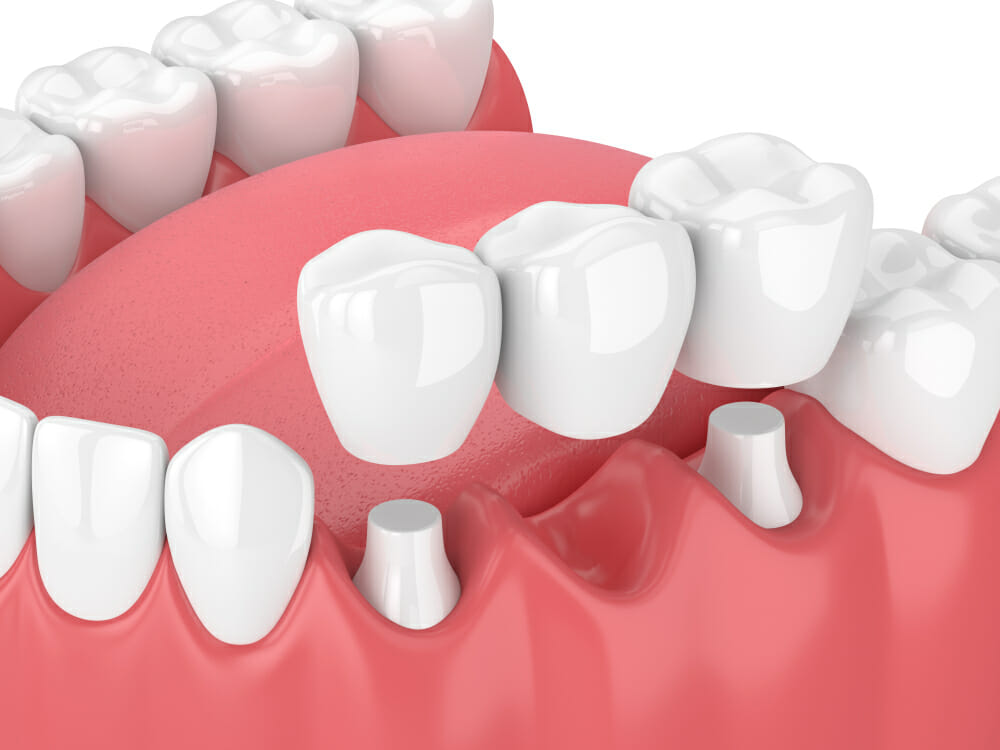What is a dental bridge, and how does it work?
A dental bridge is a prosthetic device that replaces one or more missing teeth. It consists of artificial teeth, called pontics, anchored to adjacent natural teeth or dental implants. The bridge helps restore the function and appearance of your smile by “bridging” the gap created by missing teeth.
A smile is the prettiest thing you can wear, but what if you have a missing tooth, making you conscious? Dental bridges are an excellent solution to the problem of missing teeth. They bridge the gap between one or more missing teeth, restoring your smile and dental functionality. This blog post will discuss everything you need to know about dental bridges. We will start by understanding what they are and then explore the different types of dental bridges available, including the permanent bridge. We will also discuss the benefits of getting a dental bridge and how to care for it once it’s placed in your mouth. Lastly, we will address the question – How long can a dental bridge last? So, sit back and read on to learn everything there is to know about dental bridges.
Understanding Dental Bridges
Dental bridges are dental prostheses that replace missing teeth with artificial teeth. They are cemented to the adjacent teeth or dental implants to restore the function and appearance of a natural smile. Dental bridges ensure a healthy oral structure by preventing remaining teeth from shifting and maintaining proper bite alignment. In addition, they improve speech and chewing ability. Understanding the different types of dental bridges, such as traditional bridges, Maryland bridges, implant-supported bridges, and cantilever bridges, including dental prostheses, is essential for making informed decisions about dental care.
What is a Dental Bridge?
A dental bridge consists of a pontic (false tooth) supported by dental crowns. These crowns are placed on the abutment teeth for stability. Made from materials like porcelain or alloys, bridges are custom-made to match natural teeth in color and shape. When replacing a front tooth, porcelain is most often used because it can be matched to your natural tooth color. Dental bridges offer a durable and long-lasting solution for replacing missing front teeth. Your dentist will make a temporary bridge to wear to protect the exposed teeth and gums while the bridge is being made.
Traditional Dental Bridges
Traditional dental bridges involve the creation of a crown for the missing tooth, which is then attached to the adjacent natural teeth. This type of bridge requires the removal of enamel from the neighboring teeth. Maintaining good oral hygiene is crucial for the longevity of traditional dental bridges. By carefully stitching together the false and natural teeth, traditional bridges restore the functionality and aesthetics of the mouth. They offer a durable and long-lasting solution for tooth replacement while also preventing the risk of tooth decay.
Maryland Dental Bridges
Maryland dental bridges, also known as resin-bonded bridges, provide a conservative solution for replacing missing teeth at the front of the mouth. These bridges utilize metal wings, instead of crowns or porcelain, that are bonded to the back of adjacent teeth without needing enamel removal. By supporting the pontic, or artificial tooth, on the side of the gap, Maryland bridges offer an aesthetically pleasing and functional alternative for teeth at the front of the mouth. Maintaining proper care and oral hygiene is crucial to ensure the longevity of these bridges. With Maryland Bridges, patients can enjoy restored smiles and improved oral health.
Implant-Supported Dental Bridges
Implant-supported bridges utilize dental implants as the foundation, surgically placed in the jawbone for stability. This type of bridge is ideal for multiple missing teeth, offering excellent stability and functionality. Maintaining good oral hygiene and attending regular dental visits is crucial to ensure the longevity of implant-supported bridges. By providing a robust and secure solution, implant-supported bridges effectively restore the function and aesthetics of the patient’s smile.
Cantilever Dental Bridges
Cantilever bridges, a dental bridge, are used when there is only one natural tooth on the side of the gap. These bridges are anchored to the adjacent tooth for support, making them a conservative option for tooth replacement. Careful consideration of the bite and forces exerted is necessary for the success of cantilever bridges. It is essential to have regular dental check-ups to monitor the condition of these bridges and ensure their longevity. In the case of a cantilever dental bridge, the pontic is held in place by a dental crown cemented to only one abutment tooth, providing stability and functionality to the single-tooth bridge.
Caring for Your Dental Bridge
Proper oral hygiene is vital for maintaining the health and longevity of your dental bridge. Regular brushing and flossing, including cleaning under the bridge, help prevent plaque buildup and gum disease. Visiting your dentist for check-ups and professional cleanings ensures proper care. Avoiding hard or sticky foods can prevent damage and extend the bridge’s lifespan. Following your dentist’s instructions for oral care and maintenance, as demonstrated by your dentist or dental hygienist, will keep your dental bridge in optimal condition. Maintaining a healthy oral routine and seeking regular dental care is crucial for the longevity of your dental bridge.
Conclusion
To conclude, dental bridges offer a reliable and effective solution for replacing missing teeth. With different types available, you can choose the one that suits your needs and preferences. Dental bridges restore aesthetics and functionality to your smile and protect the surrounding teeth from shifting and damage. They enhance your ability to chew and speak correctly, improving your overall quality of life. Proper care and maintenance are essential to ensure your dental bridge’s longevity. Regular cleaning and maintenance will help preserve the bridge and keep it in good condition for years. Remember to consult your dentist for professional guidance and advice on caring for your dental bridge.

